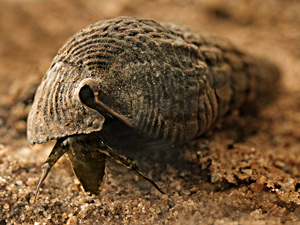
Mangrove snail (Terebralia palustris). Source: Wikipedia.
 Mangrove snail (Terebralia palustris). Source: Wikipedia. |
Class:
Gastropoda
![]() Subclass:
Orthogastropoda
Subclass:
Orthogastropoda
![]() Superorder:
Caenogastropoda
Superorder:
Caenogastropoda
![]() Order:
Neotaeniglossa
Order:
Neotaeniglossa
![]() Superfamily:
Cerithioidea
Superfamily:
Cerithioidea
![]() Family:
Melanopsidae H. a. A. Adams
1854
Family:
Melanopsidae H. a. A. Adams
1854
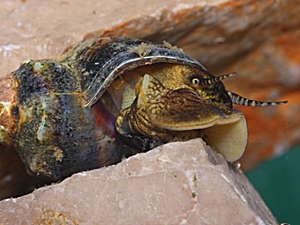 Holandriana holandrii, a Melanopsid snail from Slovenia. Picture: © Alexander Mrkvicka, Vienna (mrkvicka.at). |
![]() Source:
Mollbase on
http://www.mollbase.de/list/.
Source:
Mollbase on
http://www.mollbase.de/list/.
![]() Systematics of Gastropoda: Clade Caenogastropoda: Melanopsidae.
Systematics of Gastropoda: Clade Caenogastropoda: Melanopsidae.
Melanopsidae, of which the pitch snails are only a part (the Melanopsidae as such have no vernacular name), are a family of fresh water snails in the superfamily Cerithioidea. They are related to the sea-living ceriths (Cerithiidae, e. g. the common horn shell, Cerithium vulgare) and the mangrove snails living in the sea and in brackish water (Potamididae, e. g. Terebralia palustris).
Melanopsidae can be found in South and East Europe, in North Africa, in the Near East, New Zealand and in the fresh water streams on some islands in the South Pacific.
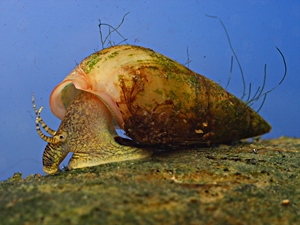 Pitch snail (Esperiana daudebartii daudebartii). Picture: © Alexander Mrkvicka, Vienna (mrkvicka.at). |
In this group hybridization (bastardization) until today plays an important role in the development of species.
For Central Europe in Mollbase four species in the genera and on subfamily are mentioned: Melanopsis pareyssii, Esperiana (Esperiana) esperi, Esperiana (Microcolpia) acicularis and Holandriana holandrii. W. Fischer additionally states two subspecies of Esperiana (Microcolpia) daudebartii, namely daudebartii and acicularis.
![]() Melanopsidae from Slovenia and Croatia: Pictures of
Esperiana esperi and Holandriana holandrii.
Melanopsidae from Slovenia and Croatia: Pictures of
Esperiana esperi and Holandriana holandrii.
Thermal Spring Pitch Snail - Esperiana (Microcolpia) daudebartii (Prevost 1821)
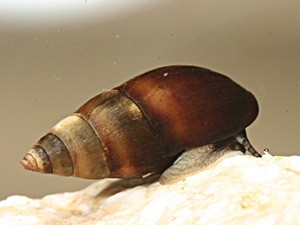 Thermal spring pitch snail (Esperiana daudebartii acicularis). Picture: © Alexander Mrkvicka, Vienna (mrkvicka.at). |
Description: The shell of the thermal spring pitch snail is pointedly conical, of a dark reddish brown to black violet colour, glossy and finely striated. The whorls of its spire are almost flat at the outside. The spire is higher than the aperture. The shell spindle is truncated at the bottom. In general the shell is more slender than that of the Pontic crown snail (Esperiana esperi).
Dimensions: H: 10 - 25 mm; W: 4 - 8 mm; N: 7 - 8. (Abbreviations).
Habitat and Distribution: Pitch snails live on stones, submerged roots or in the river bank mud of rivers in the western Black Sea area. Their distribution area stretches upstream of the river Danube until Eastern Austria and Slovakia.
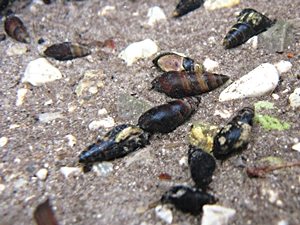 Thermal spring pitch snails (Esperiana daudebartii acicularis) in a Lower Austrian thermal spring. |
|
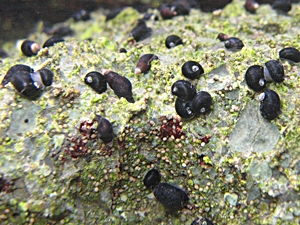 Nerites (Theodoxus prevostianus) and pitch snails. Pictures: © Alexander Mrkvicka, Vienna (mrkvicka.at). |
So together with the thermal spring nerite (Theodoxus prevostianus) and the thermal spring snail (Bythinella pareyssii) the pitch snail is especially worthy to be protected among the species found in the warm waters of the Hansy stream in Bad Vöslau, Lower Austria.
This population is a relic from the time of warmer interglacials, when the species, as can be proved by fossils, inhabited an area stretching as far as Bavaria and Thuringia. There are similar relics in Bad Fischau (likewise in Lower Austria) and the Bükk mountains in Hungary.
As fossils, many relatives of the thermal spring pitch snail have been found in Tertiary deposits (see Geological Timeline) in the Danube countries. However, it is more probable, that the special snail species living in Austrian thermal springs are relics from one of the warm interglacials, as there is no continuous chain of fossil evidence to connect them to the Tertiary period.
![]() Francisco
Welter-Schultes:
Microcolpia daudebartii species homepage.
Francisco
Welter-Schultes:
Microcolpia daudebartii species homepage.
![]() Wolfgang
Fischer:
Wolfgang
Fischer:
![]()
![]() Esperiana daudebartii daudebartii (Prevost 1821).
Esperiana daudebartii daudebartii (Prevost 1821).
![]()
![]() Checklist of Austrian Mollusca.
Checklist of Austrian Mollusca.
![]()
![]() Liste fossiler und rezenter Melanopsidae.
Liste fossiler und rezenter Melanopsidae.
![]() Martin Kohl: Freshwater Molluscan Shells:
Melanopsidae.
Martin Kohl: Freshwater Molluscan Shells:
Melanopsidae.
![]() Fischer,
W. (1994): Beiträge zur Kenntnis der rezenten und fossilen Melanopsidae II..
Über die Verbreitung und Entwicklung der Gattung Esperiana
Fischer,
W. (1994): Beiträge zur Kenntnis der rezenten und fossilen Melanopsidae II..
Über die Verbreitung und Entwicklung der Gattung Esperiana
![]() Fischer,
W. (1995): Beiträge zur Kenntnis der rezenten und fossilen Melanopsidae IV.
Bemerkungen und Berichtigungen zur Nomenklatur der Arten der Gattung Esperiana
in Mitteleuropa.- Cl. Conchylia Inf. 27(1).
Fischer,
W. (1995): Beiträge zur Kenntnis der rezenten und fossilen Melanopsidae IV.
Bemerkungen und Berichtigungen zur Nomenklatur der Arten der Gattung Esperiana
in Mitteleuropa.- Cl. Conchylia Inf. 27(1).
![]() Fischer,
W. (2002): Bemerkungen zu Glöer
(2002): Die Süßwassergastropoden Nord- und Mitteleuropas. Beträge zur Kenntnis
der rezenten und fossilen Melanopsidae VII. - N. Erste Vorarlb. Mal. Ges. 10:
5-7.
Fischer,
W. (2002): Bemerkungen zu Glöer
(2002): Die Süßwassergastropoden Nord- und Mitteleuropas. Beträge zur Kenntnis
der rezenten und fossilen Melanopsidae VII. - N. Erste Vorarlb. Mal. Ges. 10:
5-7.
![]() Reischütz
(1991): Beiträge zur Molluskenfauna Niederösterreichs, IX. Die Molluskenfauna
des Thermalabflusses von Bad Fischau (Niederösterreich). - Mitt. zool. Ges.
Braunau 5(13/16): 251-254.
Reischütz
(1991): Beiträge zur Molluskenfauna Niederösterreichs, IX. Die Molluskenfauna
des Thermalabflusses von Bad Fischau (Niederösterreich). - Mitt. zool. Ges.
Braunau 5(13/16): 251-254.
![]() Reischütz,
P. L. (1994): Beiträge zur Molluskenfauna Niederösterreichs, XI. Ist
Starobogatovismus die Steigerung von Bourguignatismus? - N. Erste Vorarlb. Mal.
Ges. 2: 51-52.
Reischütz,
P. L. (1994): Beiträge zur Molluskenfauna Niederösterreichs, XI. Ist
Starobogatovismus die Steigerung von Bourguignatismus? - N. Erste Vorarlb. Mal.
Ges. 2: 51-52.